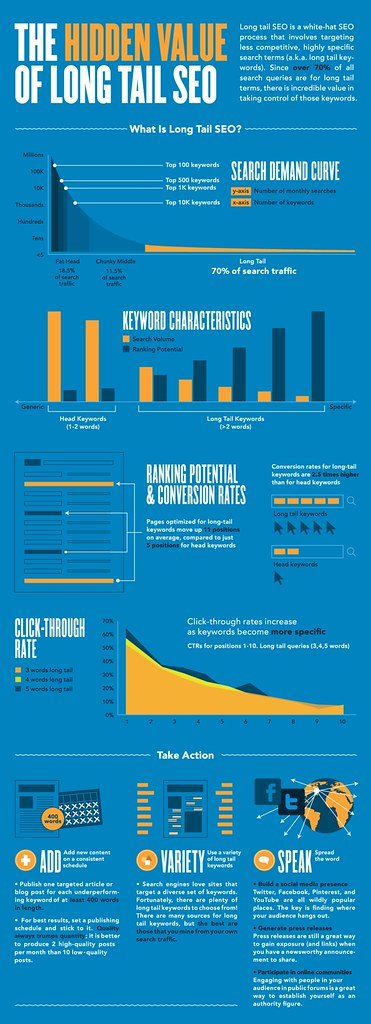In the vast ocean of search engine optimization, where every website is a ship battling for user attention, there exists a hidden treasure that only the most skilled navigators dare to uncover. A treasure, so elusive and yet so powerful, capable of steering your website towards the shores of targeted traffic and conversion success. Ladies and gentlemen, captains of the digital realm, we present to you the key to unlocking unparalleled potential – the secret lies in mastering the art of long-tail keywords.
In today’s ever-evolving digital landscape, the battle for online visibility has never been fiercer. With competition lurking around every corner and algorithms forever changing their whims, it is imperative for businesses and website owners to adapt their strategies and equip themselves with the most potent weapons at their disposal. Long gone are the days where a simple keyword would suffice to drive traffic; it is the era of precision targeting and niche conquest. It is the era of the long-tail keyword revolution.
So, what exactly are long-tail keywords, you may ask? Imagine engaging in a conversation with your potential customers, where they describe their needs and desires in a manner that is unique to each individual. Long-tail keywords are the lexical translations of these personalized conversations, crafted to cater to the specific demands of a niche audience. Gone are the days of broad and generic search terms; long-tail keywords represent the epitome of precision in targeting, as they encompass intricate phrases that mirror the exact queries users type into search engines.
In this quest for online dominance, it is crucial to understand the immense potential that lies within long-tail keywords. Rather than opting for the traditional battle against giants in the sea of generic keywords, mastering the unique combination of precise phrases allows your website to navigate its way through uncharted waters, capturing the attention of those users who are truly seeking what you have to offer. By embracing the power of long-tail keywords, your website can rise above the noise, attracting qualified leads and boosting your conversion rates like never before.
Join us on a journey through the astounding world of long-tail keywords, as we unravel their intrinsic nature, unveil the techniques required for their mastery, and explore the invaluable benefits they bestow upon those agile enough to wield them. It’s time to set sail, fellow adventurers, towards a realm of untapped potential and discover just how unlocking the power of long-tail keywords will propel your website to new horizons of digital success.
Table of Contents
- The Hidden Potential: Unveiling the Advantages of Long-Tail Keywords
- Diving Deeper: Understanding the Significance of Long-Tail Keywords in Targeting
- Unleashing Success: Strategies for Mastering Long-Tail Keywords in Your Marketing Campaigns
- Nailing it Right: Key Recommendations for Effective Utilization of Long-Tail Keywords
- Q&A
- To Wrap It Up

The Hidden Potential: Unveiling the Advantages of Long-Tail Keywords
When it comes to optimizing your website’s visibility and attracting the right audience, long-tail keywords hold an untapped potential that can truly transform your digital marketing strategy. Unlike their shorter counterparts, long-tail keywords are more specific phrases that target niche audiences. So why should you focus on long-tail keywords? Well, the advantages they offer are truly revolutionary.
First and foremost, long-tail keywords have lower competition compared to generic and highly competitive short keywords. This means that by incorporating long-tail keywords into your website content, you have a higher chance of ranking higher in search engine results. Think of it as a small fish in a big pond versus a big fish in a small pond. While the generic keyword may attract more search volume, it also attracts a horde of competitors vying for the same audience. Long-tail keywords, on the other hand, give you the opportunity to stand out in a less crowded space and reach your target users more directly.

Diving Deeper: Understanding the Significance of Long-Tail Keywords in Targeting
Long-tail keywords are a hidden gem in the world of search engine optimization (SEO). While they may not have the search volume of broader, more competitive keywords, they hold immense power when it comes to targeting your audience. So, let’s take a plunge into the wonderful world of long-tail keywords and learn how to unleash their potential for optimal targeting.
1. Precision Targeting: Long-tail keywords allow you to be highly specific in your content optimization strategy. By targeting more specific phrases, you attract users who are actively searching for exactly what you offer. For example, if you have a travel website, targeting “best budget-friendly beach resorts in Bali” instead of just “Bali resorts” can help you reach travelers who have a specific preference for affordable accommodations.
2. Reduced Competition: Unlike short generic keywords that face fierce competition, long-tail keywords open doors to a less crowded playing field. This means there’s a higher chance of your website ranking higher in search engine results, leading to increased visibility and organic traffic.

Unleashing Success: Strategies for Mastering Long-Tail Keywords in Your Marketing Campaigns
Long-tail keywords have become a buzzword in the world of digital marketing, and for good reason. These highly specific and targeted phrases have the power to unlock a world of opportunities for your business. Whether you’re just starting out or looking to revamp your marketing campaigns, mastering long-tail keywords can be a game-changer.
So, how can you harness the power of long-tail keywords for optimal targeting? Here are some strategies to get you started:
- 1. Understand the power of specificity: Long-tail keywords are all about being specific. Instead of targeting broad terms like “shoes,” focus on phrases like “comfortable running shoes for women.” By being more precise, you can reach your ideal audience and attract visitors who are more likely to convert.
- 2. Research, research, research: Investing time in thorough keyword research is crucial. Use tools like Google Keyword Planner or SEMrush to identify relevant long-tail keywords that have a decent search volume and lower competition. These tools can provide valuable insights into what your potential customers are searching for.
- 3. Tailor your content: Long-tail keywords should guide your content creation process. Create high-quality blog posts, landing pages, or product descriptions that revolve around these targeted phrases. This not only helps with SEO but also ensures that you’re providing valuable information that addresses the specific needs of your audience.
- 4. Keep an eye on your competition: Monitoring how your competitors are using long-tail keywords can provide inspiration and insights. Analyze their content strategies, identify gaps, and find creative ways to differentiate yourself. Remember, long-tail keywords allow you to stand out in a crowded marketplace, so use them to your advantage.
Mastering long-tail keywords is an ongoing process that requires constant refinement and experimentation. Don’t be afraid to tweak and adjust your strategies based on the data and feedback you receive. As you gain more experience, you’ll unlock the true potential of long-tail keywords and witness the success they can bring to your marketing campaigns.

Nailing it Right: Key Recommendations for Effective Utilization of Long-Tail Keywords
When it comes to unlocking the true power of long-tail keywords, beginners often find themselves lost in a sea of uncertainty. However, fear not! We’re here to guide you through the maze and help you master the art of utilizing these gems for optimal targeting.
1. Relevance is the Alpha and Omega: Long-tail keywords shine bright when they are highly relevant to your content. By focusing on specific, nuanced terms, you can attract a more qualified audience who are actively searching for what you offer. For example, if you own a pet store, targeting “dog collars for small breeds” instead of just “dog collars” will help you connect with the exact customers you want.
2. Less Competition, More Advantage: Long-tail keywords may have lower search volumes compared to broader ones, but they also face less competition. This means that you have a higher chance of ranking well and standing out among the crowd. Moreover, long-tail keywords often convert better since they attract users who are further along in the buying journey.
3. Think Like Your Audience: To effectively utilize long-tail keywords, put yourself in your audience’s shoes. Consider what questions they may be asking, what problems they want to solve, or what information they are seeking. Use these insights to create content that addresses their specific needs and concerns. By doing so, you’ll not only attract more targeted traffic but also establish yourself as a trusted resource.
Q&A
Q: Why are long-tail keywords important for targeted marketing?
A: Long-tail keywords play a crucial role in targeted marketing because they help businesses reach a more specific, niche audience. By using longer and more specific phrases, rather than generic keywords, businesses can precisely target potential customers who are actively searching for exactly what they offer. This increased precision often leads to higher conversion rates and ultimately, more success in online marketing campaigns.
Q: What distinguishes long-tail keywords from short keywords?
A: Long-tail keywords are longer and more specific search queries compared to short keywords. While short keywords are usually more generic and broad, long-tail keywords are phrased in a way that reflects a user’s specific search intent. For instance, instead of using a short keyword like “shoes”, a long-tail keyword might be “women’s running shoes for high arches.” The specificity of long-tail keywords allows businesses to tailor their content and offerings to match exactly what potential customers are looking for.
Q: How can businesses identify effective long-tail keywords?
A: Businesses can identify effective long-tail keywords by conducting thorough keyword research. Start by brainstorming potential phrases that users might search for when looking for your product or service. Then, utilize keyword research tools to gauge search volume and competition for these phrases. Look for long-tail keywords that have moderate to high search volume, but relatively low competition. This will help businesses find the sweet spot where they can effectively target a specific audience without facing intense competition from other businesses.
Q: Can long-tail keywords benefit businesses with both small and large budgets?
A: Absolutely! In fact, long-tail keywords are particularly beneficial for businesses with smaller budgets. Since long-tail keywords usually have lower competition, bidding on these keywords in pay-per-click (PPC) advertising campaigns tends to be more affordable. Additionally, long-tail keywords often lead to higher conversion rates because they attract users who are searching for something specific. This means that businesses, regardless of budget size, can maximize their return on investment by focusing on the power of long-tail keywords.
Q: Should businesses prioritize long-tail keywords over short keywords in their content creation?
A: It is important for businesses to strike a balance between short and long-tail keywords in their content creation. While long-tail keywords are essential for targeting specific audiences and driving conversions, short keywords still hold value in capturing a wider audience. Incorporating a mix of short and long-tail keywords allows businesses to cast a wider net, while also optimizing their content for their target audience.
Q: How can businesses effectively incorporate long-tail keywords into their content?
A: Businesses can effectively incorporate long-tail keywords into their content by implementing them strategically in key areas. These include the page title, headings, meta descriptions, and throughout the body of the content. It’s crucial to ensure that the content remains natural, valuable, and informative to the reader, rather than solely focusing on keyword insertion. By carefully integrating long-tail keywords while maintaining high-quality content, businesses can enhance their visibility to search engines while providing a positive user experience.
Q: Are there any potential challenges associated with using long-tail keywords?
A: One potential challenge with long-tail keywords is that they may have lower search volume compared to short keywords. This means that businesses might not receive as much organic traffic by solely relying on long-tail keywords. However, the quality of traffic gained through long-tail keywords is often higher, leading to better conversion rates. Additionally, businesses might need to invest additional time and effort into keyword research to identify effective long-tail keywords that strike the right balance between search volume and competition.
Q: How often should businesses revisit and update their long-tail keyword strategy?
A: Businesses should regularly revisit and update their long-tail keyword strategy to stay relevant in an ever-evolving online landscape. As search trends, consumer behavior, and industry dynamics change, businesses must adapt their keyword strategy accordingly. It is recommended to conduct keyword research at least every few months or when significant changes occur in the market. By continuously refining their long-tail keyword strategy, businesses can maintain optimal targeting and stay ahead of their competition in the digital realm.
In Retrospect
As we close the door on this journey through the realm of long-tail keywords, we invite you to embrace the power that lies within. Just like a hidden treasure longs to be discovered, these unique phrases yearn to connect you with your desired audience in ways you never thought possible.
By delving into the depths of long-tail keyword research, you have armed yourself with a formidable tool that will catapult your targeting game to new heights. No longer will you rely on generic terms that leave you lost in the vast expanse of online competition. Now, you possess the key to unlock a world where precision and relevance reign supreme.
With each meticulous keyword choice, you carve out your path to success, leading your brand towards the open gates of conversion. No longer will you be shackled by generic marketing tactics or drowned out by the echoing noise of the masses. Your brand will rise above, resonating harmoniously with the exact individuals who are seeking what you have to offer.
Remember, dear reader, that the journey to mastering long-tail keywords is never truly complete. As the lands of digital marketing continue to evolve, new possibilities and variations will emerge before you. Adapt you must, forever learning and honing your skills in this endless quest.
So, go forth, intrepid marketer. Unleash the power of long-tail keywords with unwavering determination. Embrace their essence, their hidden gems, and forge ahead with optimal targeting. Success awaits those who dare to embrace the magic that lies within the long tail.

